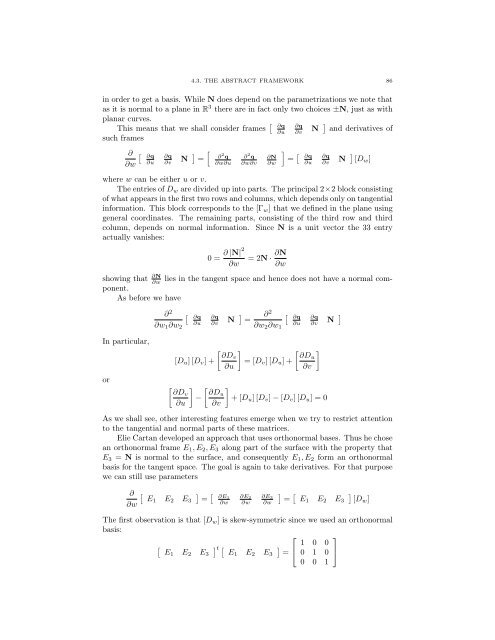Lecture Notes for 120 - UCLA Department of Mathematics
Lecture Notes for 120 - UCLA Department of Mathematics
Lecture Notes for 120 - UCLA Department of Mathematics
Create successful ePaper yourself
Turn your PDF publications into a flip-book with our unique Google optimized e-Paper software.
4.3. THE ABSTRACT FRAMEWORK 86<br />
in order to get a basis. While N does depend on the parametrizations we note that<br />
as it is normal to a plane in R 3 there are in fact only two choices ±N, just as with<br />
planar curves.<br />
This means that we shall consider frames ⇥ @q<br />
@u<br />
such frames<br />
@ ⇥ @q @q<br />
@w<br />
@u @v<br />
N ⇤ h<br />
i<br />
=<br />
@ 2 q @ 2 q @N<br />
@w@u @w@v @w<br />
@q<br />
@v<br />
= ⇥ @q<br />
@u<br />
N ⇤ and derivatives <strong>of</strong><br />
@q<br />
@v<br />
N ⇤ [D w ]<br />
where w can be either u or v.<br />
The entries <strong>of</strong> D w are divided up into parts. The principal 2⇥2 block consisting<br />
<strong>of</strong> what appears in the first two rows and columns, which depends only on tangential<br />
in<strong>for</strong>mation. This block corresponds to the [ w] that we defined in the plane using<br />
general coordinates. The remaining parts, consisting <strong>of</strong> the third row and third<br />
column, depends on normal in<strong>for</strong>mation. Since N is a unit vector the 33 entry<br />
actually vanishes:<br />
0= @ |N|2<br />
@w<br />
@N<br />
=2N ·<br />
@w<br />
showing that @N<br />
@w<br />
lies in the tangent space and hence does not have a normal component.<br />
As be<strong>for</strong>e we have<br />
In particular,<br />
or<br />
@ 2 ⇥ @q<br />
@w 1 @w<br />
@u 2<br />
apple @Dv<br />
[D u ][D v ]+<br />
@u<br />
apple @Dv<br />
@u<br />
@q<br />
@v<br />
N ⇤ @ 2 ⇥<br />
=<br />
@q<br />
@w 2 @w<br />
@u 1<br />
apple @Du<br />
@v<br />
@q<br />
@v<br />
apple @Du<br />
=[D v ][D u ]+<br />
@v<br />
+[D u ][D v ] [D v ][D u ]=0<br />
As we shall see, other interesting features emerge when we try to restrict attention<br />
to the tangential and normal parts <strong>of</strong> these matrices.<br />
Elie Cartan developed an approach that uses orthonormal bases. Thus he chose<br />
an orthonormal frame E 1 ,E 2 ,E 3 along part <strong>of</strong> the surface with the property that<br />
E 3 = N is normal to the surface, and consequently E 1 ,E 2 <strong>for</strong>m an orthonormal<br />
basis <strong>for</strong> the tangent space. The goal is again to take derivatives. For that purpose<br />
we can still use parameters<br />
N ⇤<br />
@ ⇥ ⇤ ⇥<br />
E1 E 2 E 3 = @E1<br />
@w<br />
@w<br />
@E 2<br />
@w<br />
@E 3<br />
@w<br />
⇤<br />
=<br />
⇥<br />
E1 E 2 E 3<br />
⇤<br />
[Dw ]<br />
The first observation is that [D w ] is skew-symmetric since we used an orthonormal<br />
basis:<br />
2 3<br />
⇥ ⇤ t ⇥ ⇤ 1 0 0<br />
E1 E 2 E 3 E1 E 2 E 3 = 4 0 1 0 5<br />
0 0 1
















